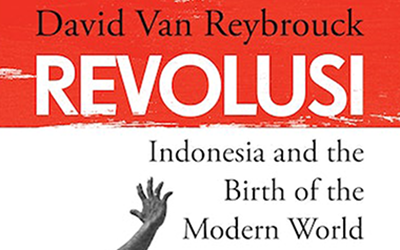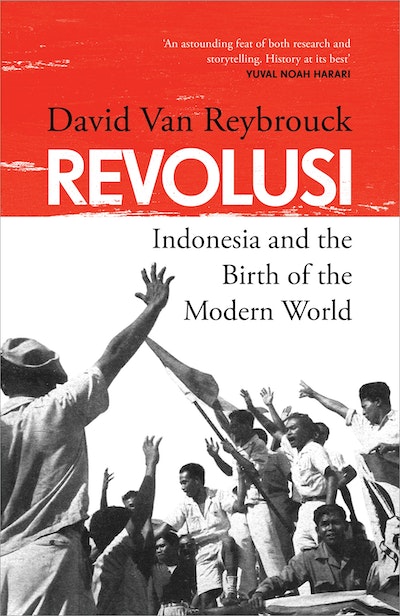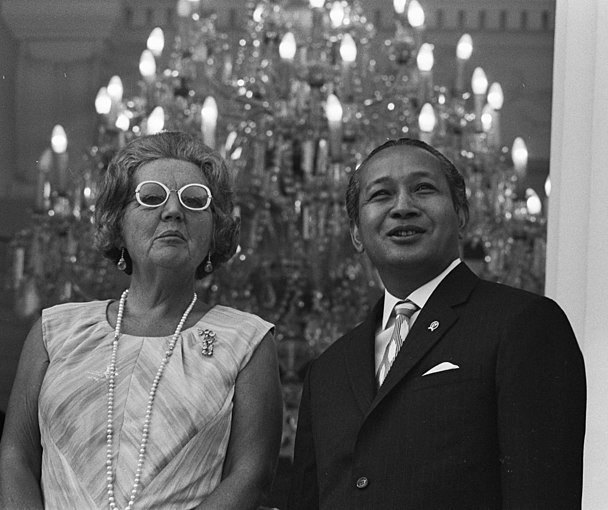
- Free Article: No
- Contents Category: Indonesia
- Review Article: Yes
- Article Title: The biggest invisible thing
- Article Subtitle: Building on a trove of unknown history
- Online Only: No
- Custom Highlight Text:
In 1906 and 1908, on the island of Bali, thousands of people dressed in ceremonial Hindu attire walked towards Dutch gunfire in acts of mass suicide known as puputan. These were not the first events of mass violence by the Dutch against the indigenous people of what we now call Indonesia – nor the last. In 1621, the native inhabitants of the Banda Islands were slaughtered en masse to secure Dutch access to nutmeg; it was the starting point for Amitav Ghosh’s brilliant non-fiction work The Nutmeg’s Curse (2021). The only Bandanese who survived were enslaved. During the so-called Dutch Golden Age of the 1600s, Batavia (now Jakarta) was home to 27,000 people – half of whom were enslaved. In 1740, the Dutch massacred almost all ethnic Chinese residents of Batavia, establishing what would become a dark history of anti-Chinese violence in the archipelago.
- Featured Image (400px * 250px):

- Alt Tag (Featured Image): Max Walden reviews ‘Revolusi: Indonesia and the birth of the modern world’ by David Van Reybrouck
- Book 1 Title: Revolusi
- Book 1 Subtitle: Indonesia and the birth of the modern world
- Book 1 Biblio: Bodley Head, $36.99 pb, 656 pp
- Book 1 Cover Small (400 x 600):

- Book 1 Cover (800 x 1200):

Revolusi: Indonesia and the birth of the modern world by David Van Reybrouck, a Belgian cultural historian, tells the epic story of Indonesia’s journey from colonial subjugation by the Dutch to wartime occupation by the Japanese and its people’s ‘vast, comprehensive, and complete’ revolution, which achieved independence. The book is translated from the Dutch by Amsterdam-based Australian writer David Colmer and David McKay, an experienced translator of Dutch texts about Indonesia. Centuries of apocalyptic violence committed by the Dutch East India Company and the Dutch colonial authorities, along with slavery, economic exploitation, and a humiliating system of racial hierarchy, provide the backdrop for the emergence of Indonesia’s anticolonial nationalist project. Then there was the pain inflicted by World War II, during which four million Indonesians died – the fifth-largest death toll from the war globally. ‘The experience of famine, scarcity and need, of sheer physical degradation, contributed to the radicalisation of young Indonesians,’ Van Reybrouck writes.
The author describes being in Jakarta during a terrorist attack in 2016, and the flurry of short-lived international media attention, to underscore Indonesia’s status as a ‘quiet giant’. It is a characterisation reminiscent of epidemiologist and writer Elizabeth Pisani’s description of Indonesia as ‘the biggest invisible thing on earth’ in her beloved travelogue Indonesia Etc (2014), one of the few books on Indonesia to have entered the Anglo-phone mainstream. Indonesia is the largest Muslim-majority society on earth and the biggest economy in Southeast Asia. ‘This is not some dusty corner of the world, but a strategically located archipelago in a vast, maritime region between India and China … If you could click on Indonesia, and drag it over to Europe on the map, it would start in Ireland and end somewhere in Kazakhstan.’ Van Reybrouck sees ‘ultra-diverse’ Indonesia – with its 300 ethnic groups, 700 languages and thousands of islands – as a fascinating, essential case study in the global struggle for postcolonial nationhood.
 Queen Juliana and President Suharto, 1971 (photograph by Joost Evers Nationaal Archief via Wikimedia Commons)
Queen Juliana and President Suharto, 1971 (photograph by Joost Evers Nationaal Archief via Wikimedia Commons)
Revolusi builds on a trove of history not widely known in the Anglosphere, nor outside academia, to tell the brutal and inspiring story of the Indonesian fight for freedom from imperial domination. Indonesia was ‘one of the first dominoes to fall’ in European colonialism’s collapse, Van Reybrouck writes, and its revolution shaped expectations worldwide about the nature of decolonisation, including encouraging newly formed nations to work together. In that way, as well as being written in a conversational, at times first-person voice and privileging the individual accounts of interviewees, Revolusi serves as the ideal prequel to American journalist Vincent Bevins’s brilliant book The Jakarta Method (2020), which told the human stories of Indonesia’s anti-communist mass murder in 1965 and contextualised the events (also little known in the Anglosphere) within the broader global history of the Cold War.
In the closing pages, Van Reybrouck notes that the ‘Jakarta method’, by which the CIA covertly encouraged an explosion of anti-communist violence and the establishment of a military-backed dictatorship, was repeated across Africa and Latin America in the following years. A trusty bastion of anti-communism during the Cold War under general-turned-president Suharto, Indonesia’s transition to democracy from 1998 gave hope to democrats across the global south, just as its successful war for independence had done.
Revolusi is the product of impressive transnational and multi-lingual field research. The author undertook ‘formal’ interviews with 185 people, mostly elderly, in nearly twenty languages, including Javanese, Balinese, Japanese, Dutch, and more. Van Reybrouck interviewed senior citizens in locations from nursing homes in the Netherlands to suburban Jakarta, and says he even found some sources in Indonesia and Japan (through their grandchildren) on the dating app Tinder – reflecting the ability of this book to not take itself too seriously while telling an epic tale of war and politics in meticulous detail.
The oral accounts of people who experienced World War II and the Indonesian War of Independence (1945-49), captured while the last eyewitnesses are alive, are what make this book so compelling. The story of Indonesian nationalist and medical student Djajeng Pratomo, who had been studying in the Netherlands and became the sole Indonesian internee at Dachau among 32,000 Europeans, is remarkable. Pratomo was forced to build machine guns for the Nazis before they put him to work as a nurse in the concentration camp. He describes subtle acts of resistance. With the Americans on the advance, the SS began executions; Pratomo attached the names and numbers of living anti-fascists to the corpses of people who had just died.
The limitations of oral history are, however, often underscored in Revolusi. Van Reybrouck, not an expert on Indonesia per se, draws sweeping conclusions from anecdotes that don’t always ring true. Where he discusses Indonesian Islam – a complex yet widely researched and written-about topic – the analysis leaves much to be desired. For example, he repeatedly refers to the popular Muslim groups Muhammadiyah and Nahdlatul Ulama (NU) as ‘apolitical’, simply because they were not Islamist (i.e. advocating the establishment of an Islamic state). Given the role of NU’s paramilitary wing Banser in anti-leftist mass killings in East Java in 1965-66, the author’s conclusion that they were ever apolitical is demonstrably untrue. Under the presidency of Indonesia’s founding father, Sukarno, the post of minister for religion typically rotated between NU and Muhammadiyah members. Eight out of ten of the country’s most recent religion ministers have been NU or Muhammadiyah.
Still, for the casual reader or engaged Indonesianist alike, this book offers a range of new insights. For one, it challenges the oft-repeated shorthand that Indonesia was colonised by the Dutch for 350 years – even included in the book’s official blurb. The island of Ambon in the eastern ‘spice islands’ of Maluku was held by the Dutch for 337 years, while Aceh in the far west was subject to European colonial rule for just twenty-eight years. Indeed, Van Reybrouck observes that the battle for Aceh was the longest colonial war in history, beginning in 1873 and ending four decades later in 1914. More than 100,000 people were killed, and the Dutch fought Aceh longer than they ruled it.
‘In a quality bookshop in Paris, Beijing or New York, it’s easier to find books about Myanmar, Afghanistan, Korea and even Armenia (countries with tens of millions of inhabitants or fewer) than Indonesia with its population of 268 million,’ David van Reybrouckwrites. This mammoth yet highly readable account of modern Indonesian history goes some way to changing that.
This article is one of a series supported by Peter McMullin AM via the Good Business Foundation.


Comments powered by CComment